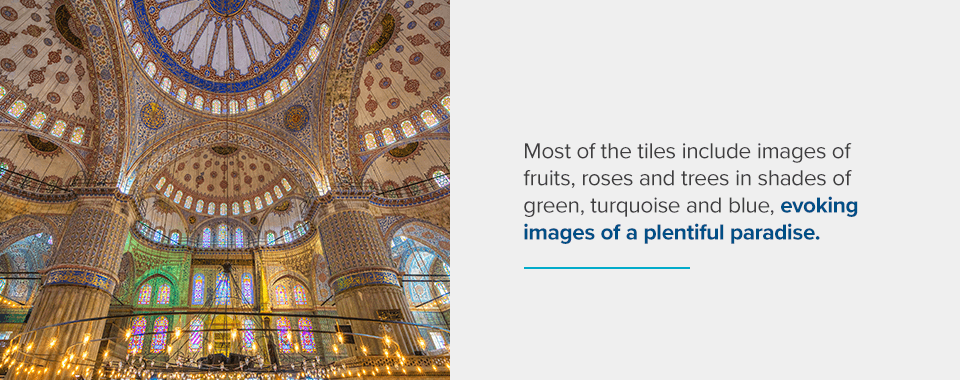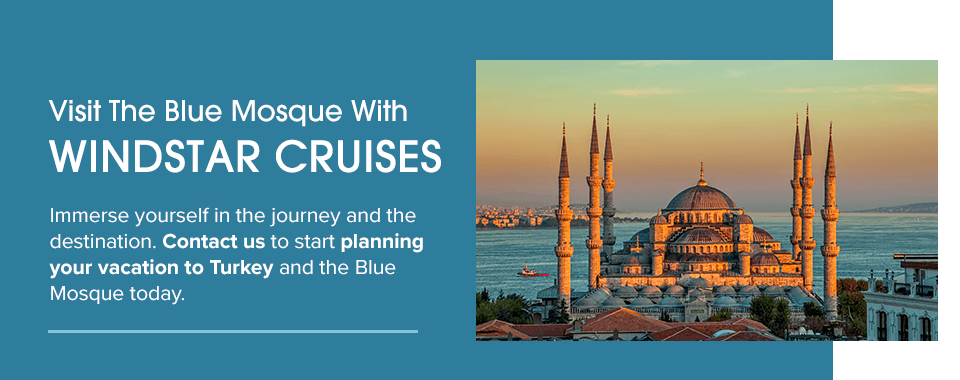
If you visit Istanbul, you’ll find it hard to miss the extraordinary mosques of the Ottoman Empire, the most famous of which is the Sultan Ahmed Mosque, better known as the Blue Mosque. Built when the Ottoman empire was at its peak, the Blue Mosque is an architectural masterpiece, from its multiple decorated minarets to its beautiful tiles and colors.
In This Article
The History of The Mosque
This architectural masterpiece has a rich, fascinating and somewhat controversial background. Let’s learn more about the Blue Mosque’s history.
Where Was It Built?
You can find the Blue Mosque in Istanbul, situated on Sultanahmet Square, where the Byzantine emperors’ palace once stood. It stands in front of the Hippodrome and the Basilica Ayasofya, also known as the Hagia Sophia Grand Mosque or the Church of Holy Wisdom.
Dominating the city skyline from the south, the Blue Mosque holds considerable symbolic significance. The Hagia Sophia was undoubtedly a source of inspiration, and the Blue Mosque can be seen as an attempt to compete with a rival civilization.
Why Was It Built?
The Ottomans had fought a devastating battle against their European enemies, the Habsburgs and another long and futile war against the Persians in the years before the Blue Mosque’s construction. In the wake of these wars, Sultan Ahmed I wanted to leave a legacy of creating beautiful architecture that reasserted Ottoman power.
Despite the grandeur of this incredible building, when construction began in 1609, it was somewhat of a bad omen. Typically, Ottoman rulers would build beautiful monuments after a successful war campaign, funding the construction with the spoils. Unfortunately, the Ottomans had experienced a crushing loss against the Persians under Sultan Ahmed I’s reign.
Who Was the Architect?
Sedefqar Mehmeti of Elbasan, also known as Sedefkar Mehmed Agha Biçakçiu, was the chief architect of the Blue Mosque. The mosque was the pinnacle of his architectural career in the pursuit of emulating his teacher — the greatest Ottoman architect, Mimar Sinan.
Originally from Albania, Mehmed traveled to Istanbul in 1563, where he spent six years as a cadet. Afterward, Mehmed specialized in mother-of-pearl inlay for twenty years before switching to architecture and receiving a position as Sinan’s apprentice.
The student aspired to surpass his teacher, and the Sultan Ahmed Mosque was his opportunity to show off his architectural style with brighter colors, immense size and magnificence.
Throughout the years, Mehmed earned many prestigious positions from his work, from Chief Bailiff to Master of the Waterways. He became chief imperial architect to the Ottoman court in 1606, and between 1609 and 1616, he exclusively worked on the Blue Mosque. Mehmed Agha passed away in 1617. Fortunately, he left a book on architecture theory containing his work methods.
What Materials Does It Use?
The Blue Mosque is composed of wood, lead and various stones, including porphyry, red granite, breccia, puddingstone and marble. Mehmed Agha used mold stone for the structure’s walls since it was lightweight and easy to manufacture. The columns of the mosque are marble, granite and porphyry.
Finally, more than 20,000 handpainted Iznik tiles are carefully arranged to rise from the midsections of the mosque.
What Does It Look Like?
The mosque is a külliye, a complex of buildings that serve various functions. This complex consists of the mosque and other facilities, including a mausoleum, a royal pavilion and a garden platform. The mosque itself has two sections — a big prayer hall crowned with a central dome and a spacious courtyard.
Unlike earlier imperial mosques in Istanbul, the outer stone walls consist of many windows and a blind arcade. The courtyard sits raised above the surrounding areas, with steps in three of its walls leading up to massive entry gates. The inner frame of the courtyard is a domed arcade that is identical on all sides except at the prayer hall entry, where the arches widen.

Four colossal columns hold up the central dome, and pendentives — delicate triangular segments — support it. Four of the six minarets are on the corners of the mosque’s prayer hall, while the other two are at the courtyard’s external corners. A succession of balconies decorates each slender, sharply pointed minaret.
The architectural highlights of the prayer hall are the sultan’s platform and an arcaded gallery that runs along the inner walls. A carved marble niche in the center of one wall directs the faithful toward Mecca, and a tall, narrow marble pulpit with an ornate turret stands to its right.
One look at the more than 20,000 handmade ceramic tiles inside is enough to understand where the name “Blue Mosque” comes from. Most of the tiles include images of fruits, roses and trees in shades of green, turquoise and blue, evoking images of a plentiful paradise. The mosque also boasts over 200 stained glass windows, a gift from the Venetian government to Sultan Ahmed.
What to Expect When You Visit
For the finest experience visiting the Blue Mosque, you’ll want to use the northwest entrance into the inner courtyard. Entering through the archway near the Hippodrome will offer you a breathtaking view of the central dome’s enormous grandeur and symmetry. The Blue Mosque in Istanbul is an active site of worship and if you arrive during the call to prayer, you’ll hear music ringing throughout the stone courtyard.
If you plan to enter the mosque, you must abide by the Blue Mosque dress code. Neither men nor women are allowed to wear tank tops, shorts or shoes. Women must cover their heads and shoulders — if you require a headcover, you can get one from the tourist entrance. Small plastic bags are a perfect solution for carrying your shoes, and shoe racks are available inside if you prefer not to bring them with you. You may only put on shoes again once you exit entirely via the western entrance.
Around the mosque, you can also visit the Hagia Sophia, Topkapi Palace and Basilica Cistern. Windstar Cruises has a team of expedition guides who can satisfy your curiosity and provide more insight, understanding and commentary on your visit to the Blue Mosque, helping you have the best time and experience.
Visit The Blue Mosque With Windstar Cruises
The Blue Mosque and its surrounding wonders will take your breath away. Connect to the splendor, authenticity and majesty of Istanbul, Turkey, with Windstar Cruises. Our small, elegant ships create an intimate excursion that leaves the crowds and clichés behind and highlights the luxuries of time, space and freedom.
Immerse yourself in the journey and the destination. Contact us to start planning your vacation to Turkey and the Blue Mosque today.




















































